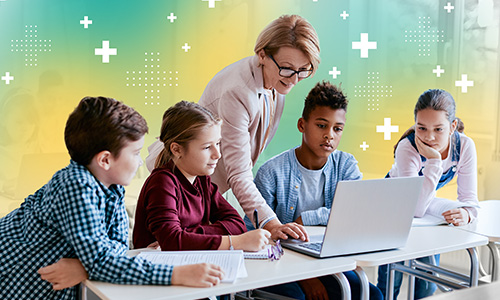 Daniel Venables, in a TeachThought blog that I still often refer to, talks about data as tools teachers can use to teach better. He provides eight sources of daily classroom data which can help inform instruction and guide teachers in making modifications of that instruction; this is classic formative assessment. My twist on these is how these eight data sources can provide students with information that helps them become better learners and take more ownership of their learning.
Daniel Venables, in a TeachThought blog that I still often refer to, talks about data as tools teachers can use to teach better. He provides eight sources of daily classroom data which can help inform instruction and guide teachers in making modifications of that instruction; this is classic formative assessment. My twist on these is how these eight data sources can provide students with information that helps them become better learners and take more ownership of their learning.
- Warm-Ups (bell work): When teachers use bell work to start a lesson, students have the opportunity to show what they know about a topic with a particular focus. It might be a pre-assessment for what’s coming today or tomorrow. Activating students’ background knowledge is a great way to honor what they know and help them recognize what they might need to know. Or, it might be a quick review of something that was a challenge from the day before or else a check-in on what happened last week. Again, this provides the students the chance to verify what they know and understand or an area where they have additional questions.
- Classwork: Providing students the chance to practice their learning in class sets up an environment where they can get help from the teacher, as well as each other. They can work on what they know, identify areas where they have questions but can keep working, and identify areas where they might be stumped. Learning to ask those needed questions in the moment is a great way for a student to demonstrate some aspects of self-regulation. Classwork also provides the teacher the opportunity to suggest additional learning tactics that a student might employ. This teaching of learning strategies within the context of learning was reported by John Hattie to have a .62 effect size.
- Checks-for-Understanding (CFUs): Whether through No-Hands-Up techniques or All-Student Response systems, students have the opportunity to check their own understanding of a topic during instruction. They may be able to compare their responses with their peers, hear the reasoning behind a peer’s response, or make adjustments to their own thinking.
- Mini-Presentations: When students prepare to “teach” something, the content takes on new meaning to them. They must clarify their own understanding before they can then act as instructional resources for their peers. These presentations afford students the opportunity to own their learning and serve as a resource for their peers. John Hattie indicated a .74 effect size for reciprocal teaching.
 Peer Review: A slight variation on Mr. Venables’ peer evaluation, or score, would be to look at peer review. This might be as simple as a checklist for an assignment where one student reviews another’s work to make sure all the components are included, and then the pair collaborates to help fill in any gaps or make a component stronger. Or, it might be more complex where students are self-assessing, then having a peer assess, and dialoguing about where there are similarities and differences. This opportunity to clarify success criteria is an important learning tactic for students. Getting clear on the learning targets is the beginning. Getting a clear picture of what success on those targets looks like, and where their work is in relationship to the target, is the step that helps students figure out what they’ll do next.
Peer Review: A slight variation on Mr. Venables’ peer evaluation, or score, would be to look at peer review. This might be as simple as a checklist for an assignment where one student reviews another’s work to make sure all the components are included, and then the pair collaborates to help fill in any gaps or make a component stronger. Or, it might be more complex where students are self-assessing, then having a peer assess, and dialoguing about where there are similarities and differences. This opportunity to clarify success criteria is an important learning tactic for students. Getting clear on the learning targets is the beginning. Getting a clear picture of what success on those targets looks like, and where their work is in relationship to the target, is the step that helps students figure out what they’ll do next.- Exit Tickets: Sometimes teachers ask students what the next step would be as a result of the data collected in exit tickets. When students have developed as learners to a point that they know what the target is, where they are in relation to the target (the data from the exit tickets) and can determine next steps for them individually or options for the class as a whole (their peers), they have expanded on both their assessment literacy (making data actionable) and their self-regulation.
- Homework: As Venable says, “Homework is a time for students to practice and grapple with ideas and skills learned during class time.” If class time has provided students with clarity on the target (academic language), a clear picture of success (use of a rubric), and the opportunity to clarify with questions (classwork), students can take (and do) what they know to self-assess on what they don’t know or where they might be ready to go next. Homework helps students figure out what they know and what they don’t know, and it sets them up to ask questions as a follow-up to help them figure out what they will do about it.
- Self-Assessment: While the “scale” I typically use for self-assessment varies from Venables’ (below), I love his language.
1 = Totally confused
2 = Shaky on this
3 = I think I get this
4 = Got it. Let’s move on
Self-assessment is a piece of being a self-regulated learner. When we can teach students 1) to self-assess where they are in their learning and set goals; 2) how to use self-assessment to monitor their own progress; 3) to self-assess on which learning tactics are getting the best results; and then 4) to reflect and react to these various self-assessments, we are teaching them to be self-regulated learners.
In Research on Classroom Assessment, in Sue Brookhart’s summary of Heidi Andrade’s work, she says, “Students are the definitive source of formative assessment information in the classroom.” Let’s also help make them a primary user of that macrodata for which they are the source!







